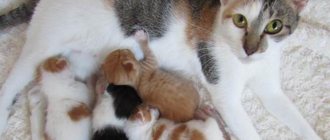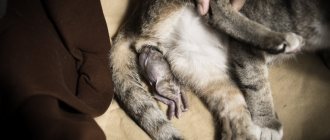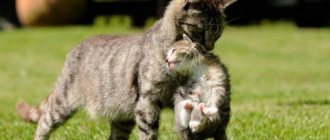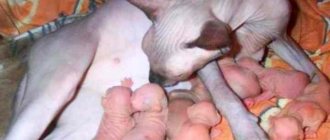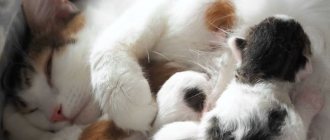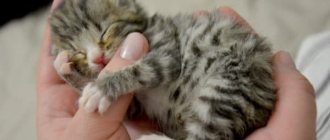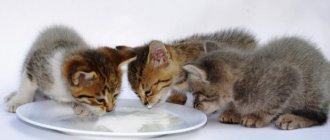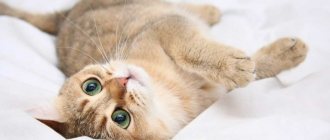A completely realistic number when the cat is left to her own devices and has free access to the street to search for suitors. But with such intense breeding, the likelihood of losing a cat or kittens is very high. The nursing mother does not have time to recover, the kittens are weak. High risks of childbirth complications. Low survival rate of offspring. This number of litters is one of the factors in the rapid death of stray cats.
Duration of pregnancy
A cat's pregnancy lasts on average about 9 weeks. A more accurate period depends on many factors such as age, weight and breed characteristics. For example, owners have found that the process of bearing offspring in short-haired females lasts 58-68 days, in cats with long and medium-length hair it lasts 63-72 days.
How many kittens can a cat give birth to?
Individual characteristics of a cat
The number of kittens born to a cat depends on a number of factors.:
- Age of the woman in labor. From a physiological point of view, it is better when a cat gives birth to kittens for the first time at the age of 1–2 years. Her body is already fully formed and she is able to bear offspring. Young cats usually have a smaller litter size (2-3 kittens) than more mature females. Occasionally, with good care, a young cat can give birth to up to six viable kittens. Adult cats usually give birth to 6–8 babies.
- Breeds. Outbred cats are more fertile than purebred cats.
- Heredity. In cats, hereditary dependence in terms of reproduction is clearly visible. The more fertile the female relatives (mother, etc.), the higher the likelihood of inheriting their reproductive qualities and producing more offspring per lamb.
- Duration of pregnancy. The longer the gestation period lasts, the fewer kittens will be born in the litter.
- Lifestyle.
- Living conditions.
- Food quality.
© shutterstock
Physiological characteristics of a cat
An important role in how many kittens a cat will have is played by the physiological characteristics of the partner.:
- Age. Excessively young or, conversely, old cats have less “productivity”.
- Number and frequency of matings. With increased sexual activity of a cat, the quality of its sperm deteriorates.
- Health. It is important that the future dad does not have diseases of the genitourinary system, as well as infectious diseases.
- Sexuality. In cats, ovulation occurs during mating and the number of eggs produced is influenced by the intensity of the partner’s “courtship.” Interestingly, felines are characterized by superfecundation, i.e. fertilization of eggs with sperm from different individuals. Thus, one litter may contain kittens from different fathers.
Features of cat pregnancy
On average, pregnancy in a cat of any variety, be it British shorthair, Scottish fold or fluffy Persian, lasts 62-63 days. If an animal bears offspring and gives birth for the first time, the period may be shorter - 56-58 days. Multiple pregnancies often lead to premature birth, and when a mother cat is carrying one or two babies, she can walk in the position for the maximum period possible. In the latter case, the offspring are born healthier and larger than from a litter with many kittens. Kitting is also easier and faster for a cat, so a low-fertility pregnancy is preferable.
What determines the timing of gestation in cats?
Pregnancy in a cat can occur after 6 months of age, when the first heat appears. The opinion of veterinarians on this matter is ambiguous, and most experts recommend not to give birth to your pet before she is 12–18 months old, because this is the most optimal age for fertilization and bearing healthy and strong kittens.
It is believed that cats with long hair and short hair have a significantly different gestation period. This opinion has no scientific evidence, but based on observations of long-haired pets during pregnancy, veterinarians noted that this period is slightly longer than that of short-haired pets. Gestation time reaches 72 days.
Shorthair cats remain pregnant for 59 to 65 days. Also, most representatives of the Siamese and Abyssinian breeds tend to bear future offspring longer than cats of other breeds.
If pregnancy is delayed, the cat should be shown to a qualified specialist.
So, if there are more than 5 kittens, labor begins a little earlier than expected. But if the time comes for the kittens to be born before the 58th day, and their number is more than 8, we can assume that they will be born dead.
Long-term pregnancy is observed in cats when there are no more than 3 kittens in the litter, and the animal is in a depressed state. However, if the timing is delayed by no more than 7 days, this is not a pathology, and kittens are born without any abnormalities.
If the pregnancy is delayed, far exceeding the upper limit of normal, you should show the cat to a qualified specialist who can help her. To do this, you need to know the exact day of mating of cats, because when fertilization occurs, the countdown of the pregnancy period begins.
Many pet owners are concerned about the question: does the number of offspring affect how long the animal will bear the offspring? Despite the fact that there is no scientific evidence for this, it is often observed that the more kittens there are, the more the cat’s gestation period can decrease. Moreover, if a large number of kittens are observed in the belly of a young cat mother, various kinds of complications may appear during pregnancy. First of all, this is due to the fact that the young animal’s body does not always tolerate such loads normally.
The number of future offspring is influenced by a number of conditions.
One of the factors influencing the number of kittens in a litter is the breed of the mother
A young cat who becomes pregnant for the first time carries fewer babies compared to a mature female. Usually in her first birth she brings 2-3 kittens. But there may be exceptions, for example, if a cat is pregnant at 5-6 months, she may give birth to 1-2 kittens, which most likely will not be viable.
Each subsequent pregnancy increases the number of fetuses. Once a cat reaches 8 years of age, the number of fetuses gestated decreases, since the elderly body is no longer able to cope with such a load. Veterinarians do not recommend giving birth to cats that have reached this age.
If the cat is pregnant for the first time
Owners often wonder if a cat can give birth to one kitten? If your pet is pregnant for the first time, it is unlikely that her litter will be large. Most likely, 2-3 kittens will be born, or even just one.
The fact is that the cat's reproductive system can only be fully formed after the first pregnancy. A future furry mother can become pregnant as early as 8 months, but this does not mean that such an early pregnancy is desirable. At the age of up to 1 year, her body is so delicate that carrying even one fetus is a risky step. Here it is important to determine not how many kittens a cat gives birth to for the first time, but how she will cope with motherhood and whether her health will be undermined.
Of course, in nature no one keeps track of when cats mate or don’t mate. But at home, a caring owner should not allow early mating at least until 1.5-2 years.
Is it possible to influence the number of kittens?
To increase a cat's fertility, there are special treatment regimens. This question is usually asked by cat breeders who sell kittens. After all, not only the expected profit directly depends on the number of offspring, but also covering the financial resources that were spent on mating with a good sire, tests, treatment, nurturing and feeding the future “money bag”.
Depending on the regalia of the male, the cost of mating can reach 10 thousand rubles. In most cases, owners of inseminators do not try to in any way influence the male health of their charges. Like we get money for mating, and then your problems: whether you got pregnant or not, how many kittens were born - it doesn’t concern us. This attitude is fundamentally wrong, and both sides should be interested in the offspring. Therefore, before you give money, ask:
- how often is a cat used for mating;
- is he eating well?
- does he have any diseases of the genitourinary system;
- how many kittens other cats bring from him;
- Does he suffer from cryptorchidism?
To increase fertility, many professionals advise injecting cats with:
- Ovariovit is a homeopathic drug, its action is aimed at restoring ovarian function, regulating the reproductive cycle and increasing fertility;
- Gamavit is an anti-stress, immunostimulating drug that supports the vitality of the body, and has a positive effect on eggs;
- Vitamin E – prevents infertility, has a positive effect on the reproductive system.
There is even a special scheme designed for 10 days:
- Ovarium (stimulates the protective function of the reproductive system) - half a cube is administered subcutaneously once a day;
- Ortilin (reduces the risk of inflammatory processes in the uterus) – one tablet twice;
- Ovariovit one tablet twice;
- vitamin E capsule twice a day;
- Gamavit one cube a day subcutaneously;
- Catozal (to normalize metabolism, increase immunity, resistance to stress) one cube per day subcutaneously.
Before putting any regimen into practice, consult your veterinarian!
Why does this work?
- Treatment may worsen estrus symptoms and increase hormone levels.
- At the same time, the cat becomes more attractive to the inseminator and is ready to attack the future father.
By the way, you can “stimulate” the cat by injecting him with B vitamins a couple of days before mating, which have a beneficial effect on the body’s endurance and activity.
Regarding the opposite effect (low fertility), there are no proven schemes as such. For example, there is an opinion that if after giving birth a cat with multiple births is left with only two kittens, then a certain switch is triggered in the body and the next time the animal will bring exactly two kittens. Although in practice, I personally have never observed such a phenomenon.
You can also do the opposite:
- poorly fed;
- keep under stress;
- exploit more often, forcing her to become pregnant every time she is in heat;
- periodically use hormones that inhibit the functioning of follicles.
In such living conditions, the body will quickly become exhausted and the cat will definitely stop giving birth a lot, if at all.
How to increase the number of kittens in a litter
This question is most often asked by those owners who are planning to breed and breed a purebred pet. It is important to understand that this is not a simple matter at all, since any mistake can have a detrimental effect on the health of the animal. Be careful not to cause any harm.
The main way to increase fertility, of course, is medications. First of all, you should pay attention to homeopathic remedies. Now in almost every pharmacy you can find at least several products that are not harmful to your pet’s health. Especially notable among them are Gamavit and Ovariovit - these drugs have a beneficial effect on the reproductive system of the expectant mother and help eggs to form in large volumes.
You can contact your veterinarian and consult with him about taking supplements such as selenium and vitamin E. Only a specialist can prescribe exact dosages based on the breed, condition and physiology of the expectant mother. Under no circumstances should you give your cat supplements yourself, otherwise there will be a risk of metabolic disorders and the development of diseases on this basis.
The process of preparing your pet for pregnancy should begin long before mating. If she is already pregnant, there is no point in doing anything.
How to determine the number of future kittens
There are several ways to find out how many kittens a cat will give birth to. Conventionally, they can be called physiological, folk and scientific methods .
- Physiological. The number of kittens depends on the number of places where fertilized eggs attach to the walls of the uterus.
- People's Experienced cat owners calculate the number of future offspring in a simple way. The number two is subtracted from the number of mammary glands in the female. This method does not give 100% results, but is still often used in practice.
- Scientific. Felinologists recommend checking the expectant mother with an ultrasound a week before the expected birth. Thus, it will be known exactly what kind of offspring to expect. Under no circumstances should you feel your cat's belly with your hands to find out how many kittens she will give birth to. Palpation can damage embryos and lead to psychological stress for the expectant mother.
How many kittens are normally born in different breeds?
An ordinary mongrel cat at the age of 14-18 months gives birth to an average of 5-6 kittens; during the second pregnancy, the number of fetuses can increase to 7-8. But purebred relatives do not boast of such fertility. The British breed often gives birth to 4-5 babies, but there has been a recorded case where a Persian cat gave birth to 15 babies. This is the maximum number of kittens even a completely healthy pet can give birth to. A purebred Scottish cat gives birth to no more than 2-3 cubs, and if the cat is not purebred, then 5-8.
Fertility of different breeds
Typically, a cat gives birth to 6–8 kittens during one pregnancy. Records also happen. There is a known case when a Persian cat was able to give birth to 15 kittens at once. However, with a large litter, there is a high probability of dead or non-viable babies. Newborns have too little body weight and, moreover, the cat does not have enough milk to feed large offspring.
© shutterstock
The record holder for the number of kittens is a tabby cat from the USA. She gave birth to 420 furry babies. This is the absolute maximum.
It is also interesting to know what kind of offspring cats of different breeds have. For example, a purebred Scottish cat can give birth to 2-3 babies. A larger number (up to will be if the father is not purebred.
For example, a purebred Scottish cat can give birth to 2-3 babies. A larger number (up to will be if the father is not purebred.
British cats have a higher average fertility. A cat usually gives birth to 4–5 kittens per lamb. But not every representative of this breed can give birth to the maximum.
In what situations might a cat need help?
Most breeds are not particularly fertile; their representatives, on average, produce 2-3 kittens, less often 4.
Pedigree cats usually have only a few kittens.
Yard cats without a breed can bear up to 8 babies at a time. There are exceptions, for example, there have been cases when a Persian cat gave birth to 15 cubs in one litter. But such a multiple litter is characterized by low weight and poor health, which sharply reduces the possibility of full growth and development. In addition, the female is simply not able to feed such a number of kittens.
For your information! Often, when more than 6 babies are born, 2-4 of the weakest ones die in the first week.
The Scottish Fold on average bears 2-3 kittens, but if mating occurs with a yard male, the number of offspring can increase to a maximum of 6-8 cubs.
The British breed and Maine Coons are classified as multiple breeds. A well-fed, healthy female can give birth to 4-6 kittens at a time.
Cats are characterized by high fertility; on average, from 3 to 8 kittens can be born in one litter.
How many babies can a cat have in her lifetime?
Over the course of her entire life, one female can give birth to up to 200 cubs. The record holder for the number of offspring was the outbred tortoiseshell cat Dusty from America, who gave birth to 420 kittens.
Modern medical technologies allow the owner to control the number and frequency of cat pregnancies, as well as facilitate the birth process. The main thing to remember is that the health of the pet and future offspring depends entirely on a balanced diet, conditions of detention and care.
Number of kittens per lambing
Cats are fertile. During a lifetime, all the offspring can amount to a hundred or even more. During one pregnancy, a mustachioed mother can carry and give birth to 5-7 kittens. There are cases that go beyond the average. The maximum recorded number of kittens is 15.
For your information! From a physiological point of view, the number of cubs born to a female rarely exceeds the number of nipples. The birth of one or two is considered a pathology for a cat, unless it is a primiparous female.
The number of kittens can be determined genetically, health status, and also depend on the breed of the cat. Street animals always bring more. In addition to difficult living conditions, this is explained by the low survival rate of offspring. Pets usually delight their owners with 5-6 kittens. Although Siamese breeds are highly fertile. The norm for them is 8-9 kittens.
We invite you to read: Character of the Scottish Fold cat
Primiparous animals usually give birth to 1-3 kittens. The explanation for this is the incompletely formed reproductive system. In this way, nature protects the cat’s young, fragile body from excessive stress and stress. Older cats also give birth to few kittens, as the reproductive function fades.
Happy cat mom
The appearance of kittens in the house is a touching moment for the owners and their pet. The cat, as a rule, copes remarkably well at all stages of pregnancy. The owners' task is to help her. In this regard, it would be appropriate:
- preventive examination by a veterinarian before mating in order to exclude diseases of the animal;
- examination of the animal by a veterinarian during gestation to identify possible pathologies. Also, if any unfavorable symptoms appear (bloody discharge, systematic vomiting, prolonged refusal to eat, fever), immediately contact a specialist;
- careful handling of animals. It is necessary to exclude assault, pushing, and independent palpation of the abdomen;
- providing high-quality nutritious nutrition with the necessary supplements of vitamins and microelements;
- maintaining hygiene. It is necessary to carefully monitor the cleanliness of the tray, since in the second half of pregnancy the cat is forced to access it more often;
- equipment of a place for birth and postnatal stay of kittens;
- support during childbirth, so that if something happens, you can seek help from a veterinarian.
In any case, childbirth is a natural process for mustachioed mothers. As a rule, they cope with everything on their own, but sometimes the situation gets out of control and the help of a veterinarian is needed. You should not ignore a visit to a specialist, so as not to lose your pregnant cat and her unborn offspring.
It is impossible to say exactly how many kittens a cat can produce in one litter. Usually an adult can
, and such a variation in the number of offspring depends on many associated factors. This is often influenced by the physiological characteristics of the pet. The animal has a bicornuate uterus, inside which a fertilized egg is stored at the initial stage of pregnancy.
Due to the fact that the space inside the uterus is not dimensionless, more than 6 kittens can very rarely be born in one litter. A peculiarity of the first birth is that the cat gives birth to half as many kittens as in subsequent pregnancies. By the way, this tendency can also be observed in old animals. In general, at an advanced age, a cat gives birth very rarely, but she can happily adopt someone else’s offspring.
Unfortunately, an animal’s pregnancy does not always go smoothly. In most cases, these pathologies do not affect the health of an adult, however, they can cause irreparable harm to future offspring. In this case, most often, help for a pet may be required in the following cases:
- if the animal refuses to eat for more than a day;
- in the event of the appearance of copious discharge with an unpleasant aroma from the cat’s genitals;
- in case of a sharp increase in the animal’s body temperature;
- in case of miscarriage.
As you can see, it is almost impossible to answer exactly how long a pet’s pregnancy lasts. Everything will depend on the physical characteristics of the animal and the course of pregnancy. The main thing is to pay due attention to the family’s favorite while bearing offspring.
How does the number of babies affect the health of the mother?
Stimulation of multiple pregnancy can lead to the development of unfavorable processes in the body of the cat and its offspring:
- The birth of weak, non-viable offspring. During pregnancy, a large number of embryos cannot always receive a sufficient amount of nutrition, and with it a minimum of useful microelements. The anatomical features of the female may be unsuitable for bearing such an offspring; accordingly, the cubs will not have enough space in the womb, which affects their size.
- Increased risk of complications during childbirth and the postpartum period, which can lead to forced surgery to remove the uterus and ovaries.
- There is a likelihood of a shortage of mother's milk in sufficient quantities for each baby, which will require owners to purchase artificial nutrition. You will also have to take the time to syringe feed the kittens.
A small pregnancy is no less fraught with consequences. For example, one kitten in the womb will receive everything it needs from its mother for several, eventually growing to a large size and getting stuck in the birth canal. And the production of a large amount of milk, which 1-2 cubs simply cannot eat on time, can lead to the development of mastitis.
How does childbirth take place and how many hours?
In order for your cat to lamb without complications and for all the kittens to be alive and healthy, you need to help your pet.
Every pet owner should provide assistance correctly and efficiently, and know the main stages and features of childbirth.
To cope with childbirth in a cat, it is enough to familiarize yourself with the process using special literature.
If an animal develops complications before or during birth, you should definitely call a veterinarian.
How does childbirth occur in a cat?
- The first stage is determined by the beginning. Contractions can be determined in accordance with the behavior of the animal. The female begins to look for a suitable place, constantly hangs around the owners and becomes noticeably nervous, experiencing painful sensations.
- After the end of the first stage, which lasts from 12 to 24 hours, the time comes for the second. At this moment the attempts begin. The cat no longer moves, the amniotic fluid is leaking. At this moment, it is advisable to stay near the pet for as long as possible.
- The cat does not need help during the birth process. It is enough to accept the kittens and lay them down so that the new mother cannot crush or injure the babies. If the kitten walks not with its head, but with its legs forward, then the animal needs help: slightly pull the kitten by the paw forward, and then down.
Lambing will end in about 1-3 hours. The young mother will begin to lick and feed her offspring. To prevent the animal from getting up again, you need to place food and drink nearby.
For the first 3 days, it is worth closely monitoring the health of the female and the offspring. During this time, problems or pathologies will appear that may affect the further quality of life.
Useful video
Share this post
- Related Posts
- What are the characteristics and compatibility of Gemini men, and what are their features according to the Chinese horoscope?
- Drawing an anime character step by step with a pencil for beginners
- How to use vodka with pepper and other ingredients to treat colds
- How to clean an automatic washing machine from an unpleasant odor
- Characteristics of a Virgo man and woman: compatibility with other zodiac signs
- Horoscope and full characteristics of the sign Scorpio
Discussion: there is 1 comment
- Materinstvo.Info: 09.15.2018 at 02:11
The article contains all the necessary information for the owner of the animal, supported by a photo in order to learn how to distinguish a cat from a cat. It will also be useful to learn how to properly feed a kitten at 10-12 weeks.Answer
Infertility and multiple pregnancy: what affects fertility
There are many theories why cats give birth to different numbers of kittens and what this depends on. Among the most widespread are:
- Influence of nutrition. If there is insufficient or poor quality food, the cat's chances of becoming pregnant are reduced. Nature seems to protect dead and weak kittens from being born. This is called nutritional infertility.
- Obesity. At the same time, many animals stop estrus, which indicates serious hormonal changes in the body. And in this condition, pregnancy cannot occur at all.
- Comfortable living conditions: cleanliness, comfort, favorable emotional climate, absence of stressful situations and other factors.
- Heredity. If the cat's mother gave birth to a small number of kittens, then you should not expect multiple pregnancies from your pet.
- Diseases of the reproductive system that affect the ability to conceive. For example, endometritis, pyometra and others.
- Temperament of a cat. Ovulation in cats occurs under the influence of the active behavior of the male during intercourse. Accordingly, the more active the partner is, the more eggs will be released and their fertilization will occur. If the cat is phlegmatic, there will be fewer kittens.
- Just like people, pets can be incompatible with each other. Therefore, if there is no pregnancy from a particular partner, you can try to change him.
- The quality of a cat's sperm also plays an important role. With prolonged abstinence or frequent sexual intercourse, it decreases sharply. It also depends on the living conditions of the animal, the psychological climate, healthy food, the general condition of the body, the absence of chronic diseases, etc.
- Hormonal imbalance in a cat, in which little follicle stimulating hormone (FSH) is released, which leads to the release of a small number of eggs. This, in turn, also applies to low-fertility pregnancies.
- Weight, age and general condition of the expectant mother’s body. Older cats give birth to fewer kittens.
- Pedigree and barn cats have different fertility rates. The latter most often give birth to many kittens, and this trend does not change with the age of the pet. Animals with blue blood have a tendency to have low-fertility pregnancies.
- Some breeders believe that the number of offspring is related to the number of matings. After the first time, one or two kittens are born, by 7 - the maximum possible for a given individual, and then their number decreases again.
- Another opinion is that the faster intercourse occurs from the beginning of estrus, the greater the number of new pets will be born.
All these theories have both confirmation and refutation. For example, if you adhere to the opinion that nutrition and stress affect pregnancy, it turns out that yard cats that do not have owners should not give birth at all, but they bring the maximum number of pets and calmly bear and raise them in the future. At the same time, females who are in calm home conditions with sufficient nutrition and care cannot always please their owners with kittens.
Also read about discharge from a pregnant cat.
Search for a place
A place for a woman in labor can be arranged on a bed or using a tray. The most suitable option is a cardboard box, the bottom of which is covered with paper. Qualities that a birthing place must meet:
- The box should be closed, but large in size, since the animal will live there with the kittens for several months.
- For convenience, one wall of the box is cut off. This will allow the cat to freely enter the bed area without jumping over the barrier each time.
- The prepared house is installed in a quiet place, closed from prying eyes. This could be the bathroom, a corner of the room behind the sofa, or a closet.
If the cat ignored the chosen place and hid in the closet, this is an indicator that it lacks silence and feels unprotected.
Features of pregnancy and childbirth in different breeds
Felinologists have noted a certain tendency during pregnancy in different breeds of cats:
- Representatives of cats with long hair reach maturity later than their short-haired counterparts, and their pregnancy lasts longer.
- Scottish Folds and British Folds give birth to fairly large kittens and often require veterinary care. And also the gestation period for their kittens is longer - up to 72 days, which leads to an increase in the size of the future offspring.
- With frequent pregnancies, the cat's body quickly depletes. This is a very important factor to consider when breeding animals.
- The duration of multiple pregnancies is most often reduced. Since this triggers natural protective mechanisms that prevent excessive exhaustion of the mother. The size of the kittens will also be slightly smaller compared to their counterparts born from a normal pregnancy. But this is compensated for, and they catch up with their peers in weight and development very quickly.
- Cats older than 7 years often give birth to pets with congenital anomalies or weakened ones. Therefore, upon reaching this age, it is recommended to stop mating. Such signs indicate the weakened health of the mother herself, which means there is no need to undermine it even more.
Sterilization of a cat after birth
A cat's birth may involve complications, one of which may require a caesarean section. Of course, this is not an indicator for sterilization, but still a clear sign of a problem in the reproductive system.
It does not seem possible that a loving owner would again subject a furry creature to another painful birth or another caesarean section. In these cases, the clinic is consulted about sterilization. If a cat is sterilized during a caesarean section, then the procedure is more dangerous than the one that will be prescribed according to plan. In addition to complications from the operation, the cat may refuse to feed its offspring.
When is a cat spayed after giving birth according to plan? Usually the procedure is prescribed at the end of lactation, that is, 2.5-3 months after the birth of kittens. The kittens are isolated, or a blanket is put on the cat - milk should stop forming.
The veterinarian will advise which method of sterilization is most suitable for the cat who gave birth.
What determines the number of fruits?
Each time a cat can give birth to a different number of cubs, and the pet does not kitten at the same time. How many kittens a pet brings per year depends on the following factors:
The physiological characteristics of the cat play an important role in the number of offspring. A gentleman who is too young or too old is characterized by minimal productivity. Cats that are sexually active have low quality sperm. In addition, it is worth paying attention to the health status of the future dad. If there is a history of infectious diseases of the genitourinary system or progressive urolithiasis, mating with such a sire is not recommended.
Representatives of felines are characterized by superfecundation, in which eggs are fertilized by sperm from several partners. As a result, in one litter a cat brings offspring from completely different males.
How many kittens will a cat have in a year and in her entire life?
It is almost impossible to accurately determine the number of kittens that a cat can produce in a year, much less in its entire life.
Figures may be approximate and depend on many factors and conditions.
What conditions can affect the number of offspring:
- The average cat of reproductive age can produce 5 kittens in one lambing. Depending on the number of matings, cat lovers should expect from 10 to 20 kittens per year. Over an average lifespan, the number can reach 140 individuals.
- If the female is fertile enough, approximately 25 kittens can be expected per year. Over a lifetime, the number may be 250 individuals.
- A particularly fertile female can give birth to up to 30 kittens over the course of a year. Over the entire period of existence - 300 kittens.
The figures are approximate and limited by quantity, not quality.
Some cats live long enough to produce offspring throughout their lives. Others give birth less frequently and up to a certain age.
Attention! The cat will not be in a stressful state if the number of lambings in 365 days is 3-4 times.
Owners can independently control the number of lambings of their pet, therefore they directly influence the size of the offspring.
If the animal is often sick, or the birth was complicated, then it is worth limiting the number of matings.
How often can you give birth?
A sensitive issue that worries good owners concerns how often a cat can give birth. There are several opinions that differ significantly.
Note! When making a decision, it is worth considering the cat's health characteristics.
Veterinarians and professional breeders of certain breeds give different recommendations regarding the frequency of lambing.
Fans adhere to completely different norms, dosing cats with hormonal pills at the time of estrus to stop the process.
How often can a cat give birth:
| Who makes the recommendation regarding the issue? | Top advice regarding lambing |
| Experienced cat breeders | It is recommended to breed a female according to the plan. Typically lambing is planned once a year. It is believed that the female’s body is in harmony and the quality of the litter will be much better |
| Experienced hosts | They say that it is enough for a cat to give birth 2 times a year. This will allow you not to overstrain your body and keep it in good shape. Otherwise, the animal begins to get sick often and behave inappropriately. |
| Veterinarians | Catch a cat when it comes into heat. Therefore, births may not be limited to 3-4 in 1 year. If the animal's needs are ignored, health problems may arise, leading to infertility and even death. |
How many kittens can a cat give birth to?
Cats reach sexual maturity at approximately 8-9 months. And before the age of 1 year, she is already able to become pregnant and bear offspring. However, experienced breeders understand that this is quite early, and consider such births to be risk factors, since the body is still too young.
Note to the owner! It is not recommended to breed domestic cats under 1 year of age, although in the case of backyard dwellers we cannot in any way influence this fact. It is advisable to wait until the cat is one and a half years old, when the cat’s body is stronger and ready to bear healthy offspring.
How to help a cat during its first birth
Usually a cat instinctively knows how and what to do during childbirth, but for the first time it may get scared and hide in an inaccessible place, for example, under the bed. Therefore, it is important for the owner to prepare in advance for such an important process.
How to prepare a place for childbirth
When giving preference to a place for childbirth, you need to adhere to some rules:
- Availability. Having made a box with bedding for a future woman in labor, it is important to make sure that she does not have to jump into it. You can cut out the door or remove part of the wall, then both the cat and the owner will have greater access inside.
- Capacity. It must be remembered that the pet, along with the born kittens, will be there not for one day, but for up to 2 months, so there should be enough space for both the mother and the growing offspring.
- Silence. Select a place in an apartment or house where it will be as quiet and peaceful as possible; this could be a secluded corner or the space between the sofa and the wall. Otherwise, the cat will start to worry and hide, for example, in a closet. This behavior indicates that she does not feel protected in the designated area and you need to think about moving her to a quieter place.
- Convenience. It is worth putting a layer of clean old cloth or gauze at the bottom of the box; you can buy special absorbent sheets at the pharmacy. This will create additional comfort for the woman in labor.
